Keeping your GE dishwasher clean and free from food debris is essential for maintaining its efficiency and ensuring your dishes come out spotless. Over time, leftover food particles can accumulate in the dishwasher, potentially causing unpleasant odors or even blockages. Fortunately, with a few simple steps, you can easily remove food debris and keep your dishwasher running at its best. This guide will walk you through the process of how to remove food debris from ge dishwasher.
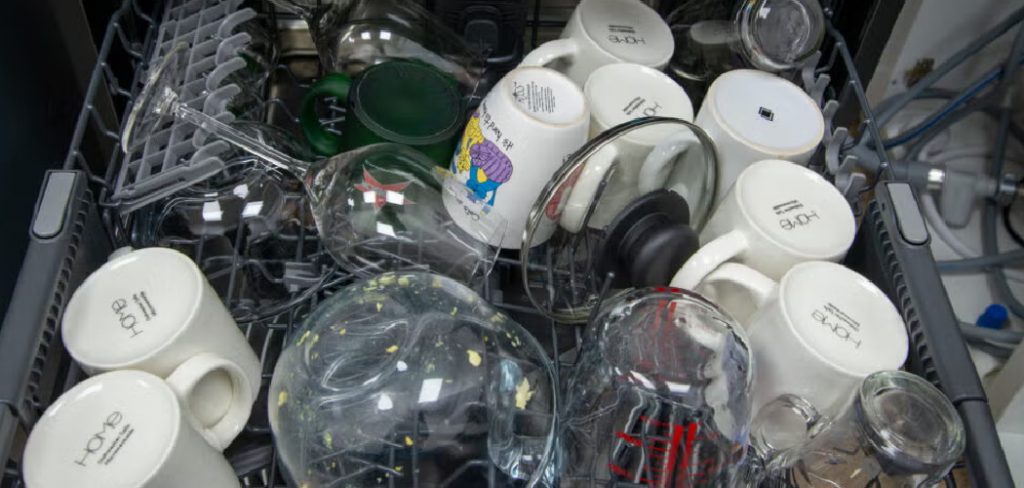
Why Food Debris Accumulates in Dishwashers
Food debris can accumulate in dishwashers due to a variety of reasons. Often, this happens when dishes are not properly rinsed before being loaded into the dishwasher. While modern dishwashers are designed to handle small amounts of food residue, larger or sticky particles can become trapped in the filter, spray arms, or crevices of the appliance. Over time, grease, oils, and other residues can combine with these food particles, creating buildups that are harder to remove.
Additionally, hard water can contribute to the issue by leaving mineral deposits that mix with food debris, making it more likely to clog components. Regular maintenance and proper usage are key to preventing excessive accumulation and ensuring your dishwasher continues working effectively.
Tools and Supplies Needed
Before you begin cleaning your GE dishwasher, gather the following tools and supplies to make the process easier and more efficient:
- Soft Sponge or Dishcloth: For wiping down the interior surfaces and components.
- Soft-bristle Brush or Toothbrush: To gently scrub hard-to-reach areas, like spray arms or filters.
- Mild Dish Soap or Detergent: For cleaning surfaces without causing damage.
- White Vinegar: A natural cleaner that helps to break down grease and mineral deposits.
- Baking Soda: For deodorizing and scrubbing away stubborn debris.
- Small Container or Bowl: To soak any removable parts for deeper cleaning.
- Toothpick or Needle: Useful for unclogging spray arm holes.
- Rubber Gloves (Optional): To protect your hands during the cleaning process.
Having these items ready will make the cleaning process much smoother and help ensure your dishwasher is thoroughly cleaned and maintained.
Safety Precautions
Before cleaning your GE dishwasher, it’s important to follow safety precautions to avoid injury or damage to the appliance:
- Turn Off the Power: Always unplug the dishwasher or turn off its circuit breaker to ensure there is no electrical power running to the appliance while you clean.
- Ensure the Dishwasher is Cool: Make sure the dishwasher and its components have completely cooled down before you start cleaning to prevent burns or discomfort.
- Wear Gloves: Rubber gloves can protect your hands from sharp objects, like broken glass or sharp edges on filters, as well as from cleaning agents.
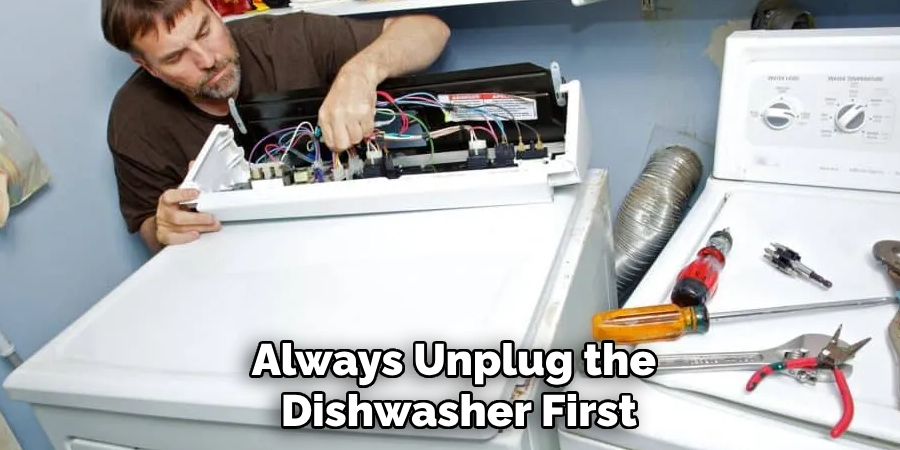
- Avoid Harsh Chemicals: Use gentle cleaning solutions, such as mild dish soap, vinegar, or baking soda, to prevent damage to the dishwasher’s internal components.
- Handle Parts Carefully: When removing or cleaning delicate parts, like spray arms or filters, handle them with care to avoid breaking or damaging them.
- Ventilate The Area: If you’re using vinegar or other cleaning materials, make sure the area is well-ventilated to avoid strong odors building up.
By adhering to these precautions, you’ll minimize risks and ensure a safe and efficient cleaning process.
10 Methods How to Remove Food Debris from Ge Dishwasher
1. Remove and Clean the Dishwasher Filter
One of the most common places where food debris accumulates in a GE dishwasher is the filter. The filter is responsible for trapping food particles and preventing them from clogging the drain. Over time, if not cleaned, it can become clogged, leading to dirty dishes and unpleasant odors.
To remove the filter, locate it at the bottom of the dishwasher, usually beneath the lower spray arm. Most filters can be twisted counterclockwise to unlock and then lifted out. Once removed, rinse the filter thoroughly under warm running water, using a soft brush or sponge to scrub away any trapped food particles. For stubborn debris, soaking the filter in a mixture of warm water and mild dish soap can help loosen any buildup.
2. Clear the Spray Arms
The spray arms in a GE dishwasher distribute water to clean dishes efficiently. However, small food particles can become lodged in the tiny holes of the spray arms, reducing water pressure and overall cleaning effectiveness.
To clean the spray arms, carefully remove them from the dishwasher by unscrewing or unclipping them, depending on your dishwasher model. Use a small toothpick, needle, or wire brush to clear out any clogged holes. Running warm water through the spray arm can help flush out remaining debris. Once cleaned, reattach the spray arms securely to ensure proper water flow during the next wash cycle.
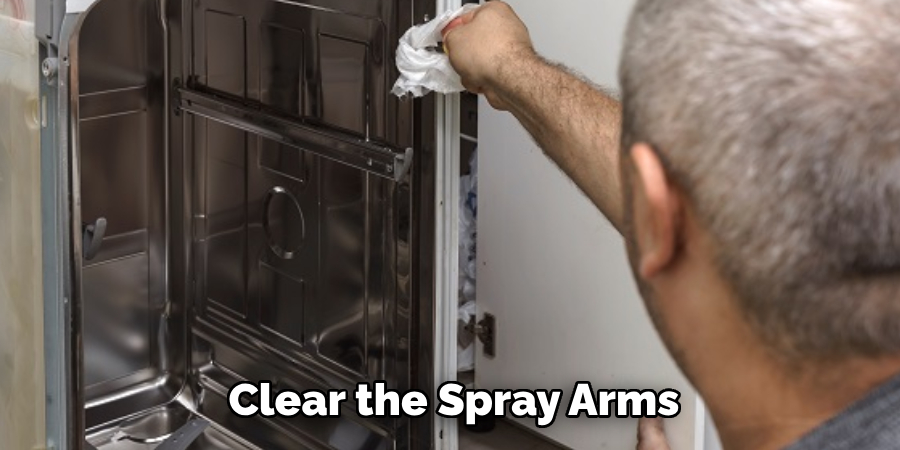
3. Wipe Down the Dishwasher Interior
Food debris can often accumulate on the walls and door of your dishwasher, especially if large food particles are not rinsed off before loading dishes. A simple but effective way to maintain a clean dishwasher is to wipe down the interior surfaces regularly.
Use a damp microfiber cloth or sponge dipped in warm soapy water to wipe the interior walls, door, and edges where food particles may be trapped. For stubborn stains or grease buildup, a solution of equal parts vinegar and water can be used to break down residue and eliminate odors.
4. Clean the Drain Area
The drain area at the bottom of your GE dishwasher is another hotspot where food debris tends to accumulate. A clogged drain can result in standing water in the dishwasher and prevent proper drainage.
To clean the drain, remove any visible food particles by hand or with a soft brush. If the drain cover is removable, take it off and check for trapped debris inside. Flushing the drain with hot water and baking soda can help dissolve any grease or small food particles that may be blocking the flow.
5. Run a Vinegar Cleaning Cycle
Vinegar is a natural cleaning agent that helps dissolve grease, food particles, and mineral deposits inside a dishwasher. Running a vinegar cleaning cycle can effectively remove food debris and eliminate any lingering odors.
To use this method, place a bowl of white vinegar on the top rack of an empty dishwasher. Run a hot water cycle without adding detergent. The vinegar will help break down food residue, grease, and soap scum, leaving the interior fresh and clean.
6. Use Baking Soda for Deep Cleaning
Baking soda is another excellent natural cleaner that helps remove food debris and neutralize odors in your GE dishwasher. It is especially useful for tackling tough stains and greasy buildup.
After running a vinegar cycle, sprinkle one cup of baking soda evenly across the bottom of the dishwasher. Run a short hot water cycle, allowing the baking soda to absorb odors and scrub away lingering food particles. This method helps to refresh the dishwasher and improve its overall performance.
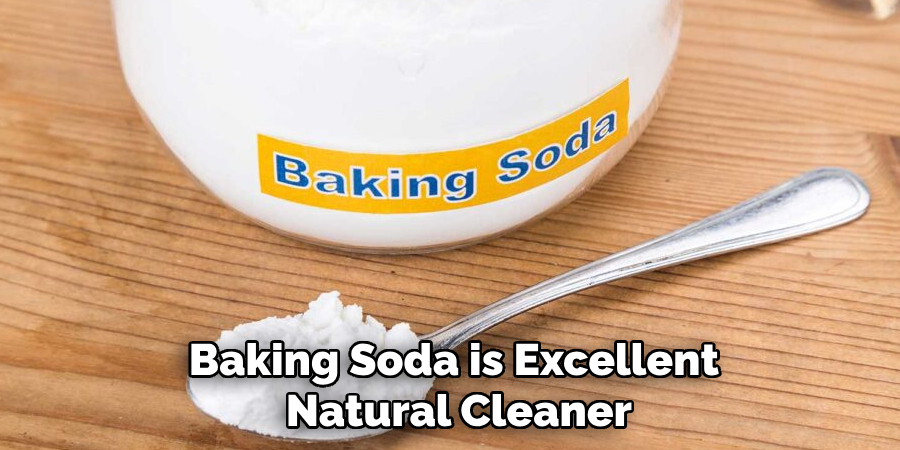
7. Check and Clean the Silverware Basket
The silverware basket in a dishwasher often traps small food particles, especially if utensils are loaded with food residue. Over time, food debris can become stuck in the small compartments, leading to bad odors and reduced cleaning efficiency.
To clean the silverware basket, remove it from the dishwasher and rinse it thoroughly under warm running water. Use a soft brush or an old toothbrush to scrub away any trapped food debris. If needed, soak the basket in a mixture of warm water and dish soap for a few minutes to loosen stubborn grime before rinsing and replacing it.
8. Inspect and Clean the Door Gasket
The rubber door gasket or seal around the dishwasher door helps prevent water from leaking out during a wash cycle. However, this area can also trap food debris, soap scum, and grease over time.
To clean the door gasket, use a soft cloth or sponge dipped in warm soapy water to wipe around the edges. For stubborn grime, a toothbrush or cotton swab can be used to get into tight spaces. Regularly cleaning the gasket helps maintain a proper seal and prevents mold or mildew buildup.
9. Run a Dishwasher Cleaner for Heavy Debris Buildup
If your GE dishwasher has significant food debris buildup that cannot be easily removed using household items, using a commercial dishwasher cleaner may be the best solution. These cleaners are specifically designed to dissolve grease, limescale, and food particles that accumulate inside the dishwasher.
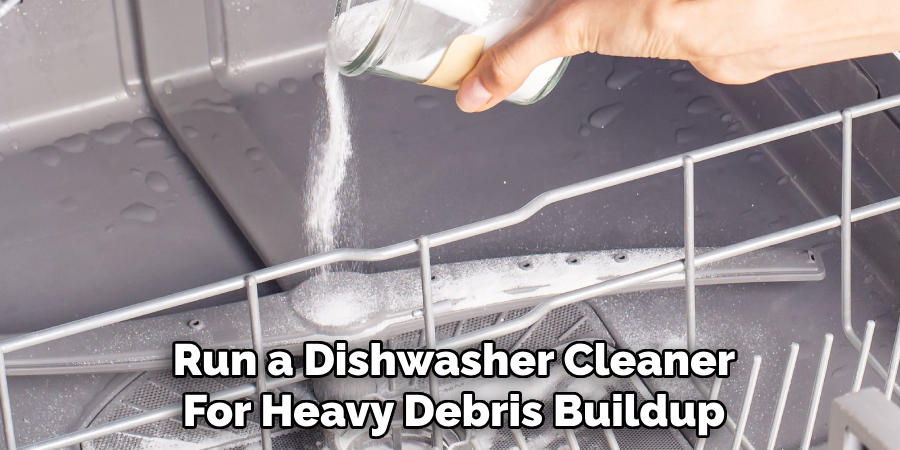
Follow the instructions on the dishwasher cleaner packaging, usually by placing the cleaner inside an empty dishwasher and running a hot water cycle. This method is especially useful if your dishwasher has developed a musty smell or is not cleaning dishes properly due to excessive debris buildup.
10. Prevent Future Food Debris Buildup
Prevention is key to keeping your GE dishwasher running efficiently and free from excessive food debris. To reduce buildup, follow these simple maintenance tips:
- Scrape off excess food from dishes before loading them into the dishwasher.
- Rinse dishes lightly to prevent large food particles from clogging the filter or spray arms.
- Run a hot water cycle with vinegar or baking soda at least once a month to keep the interior clean.
- Regularly inspect and clean the filter, drain, and spray arms to ensure optimal performance.
By adopting these preventative measures, you can significantly reduce food debris accumulation and keep your dishwasher working like new for years to come.
Conclusion
Removing food debris from a GE dishwasher is essential for maintaining its cleaning efficiency and preventing unpleasant odors. By following these ten methods—cleaning the filter, spray arms, and drain, running vinegar and baking soda cycles, and inspecting key areas like the silverware basket and door gasket—you can effectively remove trapped food particles and ensure your dishwasher performs at its best. So, there you have it – a quick and easy guide on how to remove food debris from ge dishwasher.
Professional Focus
Angela Ervin, a former interior designer turned blogger, specializes in kitchen design and renovations. Through her website, she blends her passion for cooking with design expertise, sharing practical and creative ideas. Known for balancing functionality and beauty, Angela’s insightful content has made her a trusted voice in home design and lifestyle.
About the Author
Angela Ervin, an experienced interior designer and blogger, combines her passion for kitchen renovations with storytelling. Living in Petersburg with her family, she enjoys cooking and testing her projects firsthand. Known for her humor and relatable style, Angela shares creative, functional design insights through her content, making her a trusted voice in home design.
Education History
University: Virginia Commonwealth University
Degree: Bachelor of Fine Arts (BFA) in Interior Design
- Angela’s education at VCU focused on mastering core interior design principles, including spatial planning, color theory, materials selection, and sustainable design practices.
- She gained hands-on experience through studio projects and collaborative design exercises, which honed her ability to create functional and aesthetically pleasing environments.
- Her coursework also emphasized problem-solving and practical applications of design, preparing her for real-world projects like her self-directed kitchen renovations.
- The program’s strong foundation in both technical skills and creative expression shaped Angela’s ability to seamlessly integrate form and function in her work.
